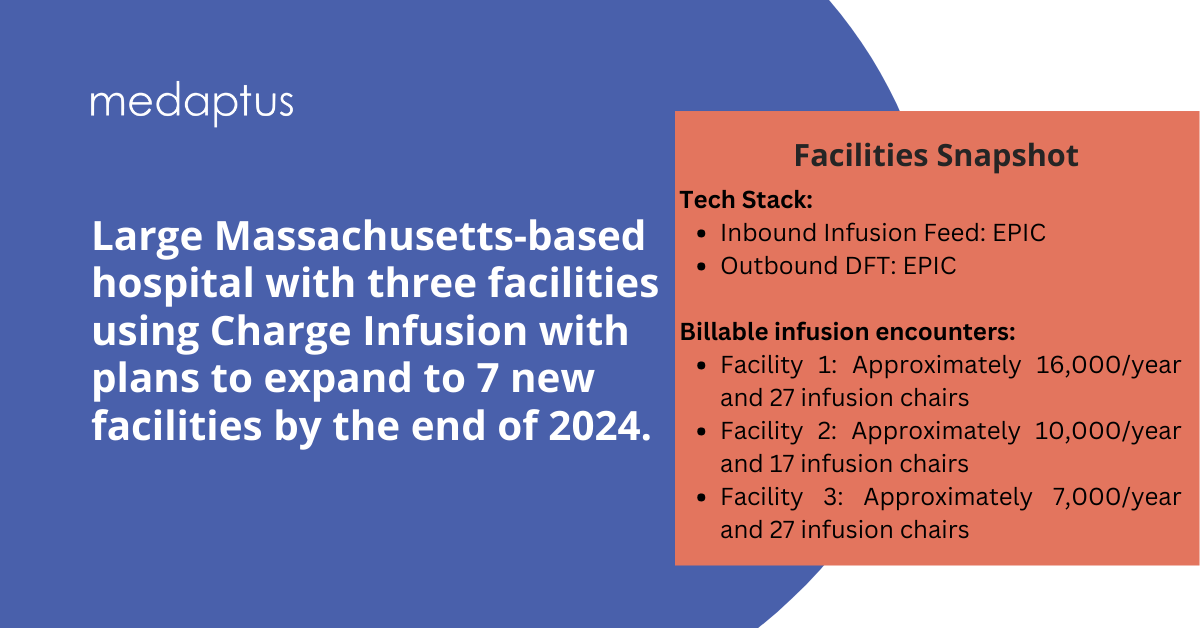Did you know that we audited some emergency departments across the US and found that up to 50% of hydration infusions were documented incorrectly?
Underbilling for infusion services in the ED and in high-volume infusion locations like cancer centers, can be costing you thousands or millions in lost revenue every year.
Why?
The Challenges with Infusion Coding
When working with a Massachusetts-based hospital to improve their outpatient infusion coding and billing, the common challenges I heard about were:
- Coders had to review every single charge
- Charges were getting missed since the infusion hierarchy for billing purposes was being calculated manually
- Nurses were entering charges which was inefficient and not a good use of resources, taking time away from patient care and their already heavy workloads
- or someone else would need to pick up the slack and then becomes overworked
- There was the potential for compliance issues due to missing documentation, such as missing stop times or missing drug charges
Sound familiar? You’re not alone. Infusion coding and billing is complex, which is why so many hospitals have full-time coders devoted just to infusion billing. But throwing more resources at the problem, especially in the worst labor shortage the healthcare industry has ever seen, is not always the answer.
Infusion Coding Lessons Learned from Massachusetts Cancer Center
I recently worked with a Massachusetts-based hospital who uses our Charge Infusion software, the industry’s only fully automated infusion coding software that integrates with your EHR, to ensure you’re not under-billing for infusion services.
We started with one pilot site in 2020, and due to the positive return they saw (a significant increase in infusion revenue), we expanded to another site in 2021 and another in 2022.
Improving Infusion Coding and Billing Success Story
Here’s how we helped them improve their infusion coding and billing processes so they could be assured they are not under-billing for infusion services and using their staff efficiently.
- Infusion Data Pull – Daily File: Medaptus currently uses a daily query to pull data out of the Epic Clarity database via the MIDC (Medaptus Infusion Data Collector).
- They’re able to automatically export 95% of their charges on most days, with much of the remaining 5% being custom hold edits requested by them
- Their previous workflow entailed 4 full-time coders who specifically reviewed nurse charge entry, who reached out to nurses when incorrect. After Medaptus in place, they were able to re-allocate 3 full-time coders to other areas of the business, and only have 1 remaining FTE focused on infusion coding
- These processes helped them feel confident they had the information they needed to ensure compliance (such as stop times and drug charges) to ensure valid orders that were not documented in the MAR.
- Medaptus assisted in highlighting the root cause analysis to provide feedback to the clinical side of things, highlighting adjustments needed for a best practice in Epic.
- CCI coding edits, captured standardly in Medaptus, have been a great help for their team as these change annually
- Increased revenue from infusion coding now that their charges and infusion hierarchies were being calculated automatically
Key Takeaways
Infusion coding and billing is complex – from determining the correct infusion hierarchies for billing, manually calculating start and stop times, to having nurses or admin staff bill when they are not trained to do so – it’s easy to let that result in lost revenue.
Don’t miss out on infusion revenue that you could be billing for. Learn more about the industry’s only EHR-integrated automated infusion coding software here.
Get the latest updates and news delivered to your inbox.
Subscribe to our newsletter today.






